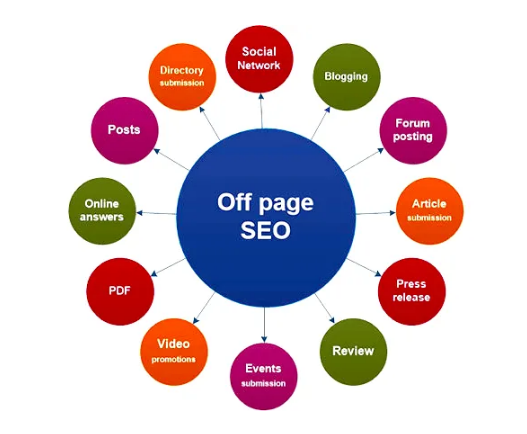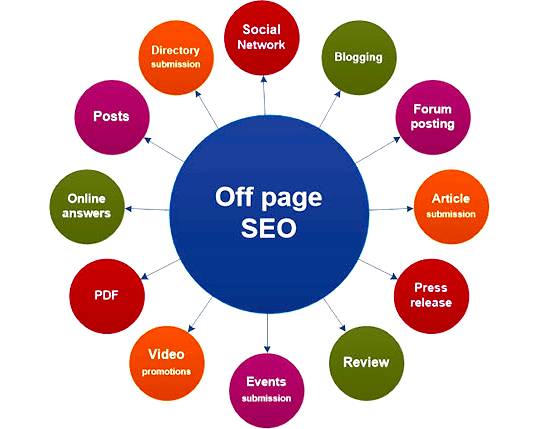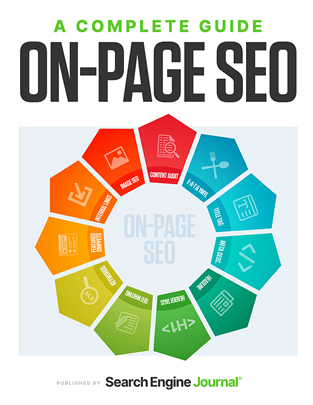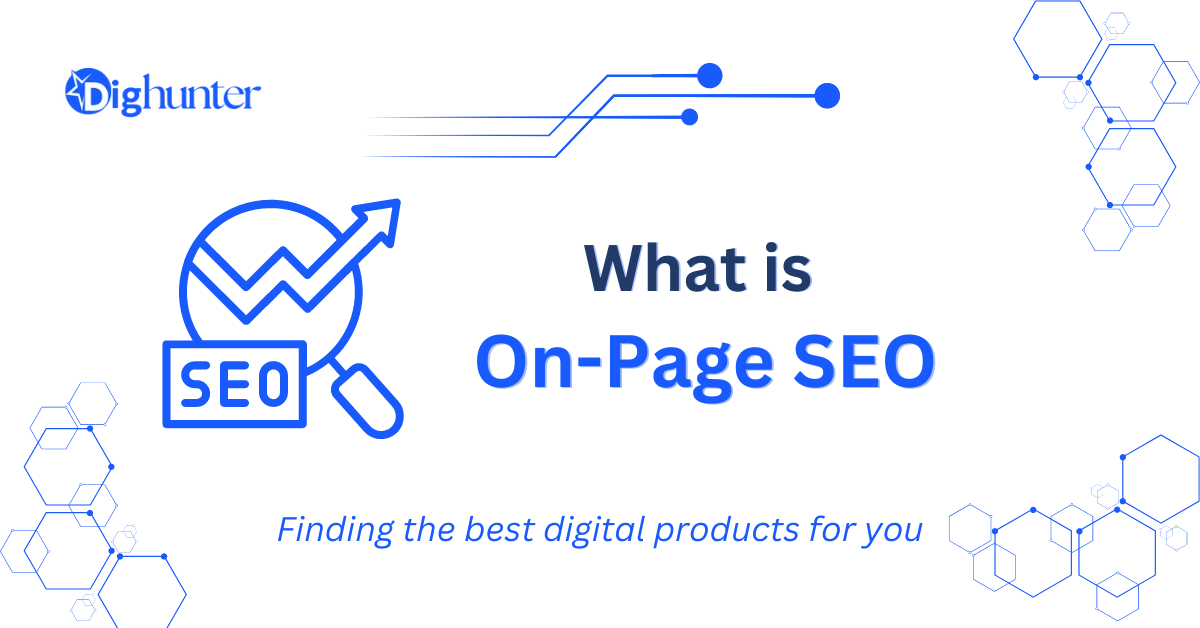On-page SEO techniques include optimizing meta tags, headings, and content. These strategies improve a website’s visibility and ranking on search engines.
On-page SEO is crucial for enhancing your website’s search engine performance. By focusing on elements like meta tags, headings, and high-quality content, you ensure search engines can easily understand and index your site. Effective on-page SEO also involves optimizing images, internal links, and URL structure.
Keyword placement within the content is essential for relevance. User experience factors such as page speed and mobile-friendliness play a significant role. Regularly updating your content keeps it fresh and engaging. Implementing these techniques can lead to higher organic traffic, better user engagement, and improved conversion rates. Besides, your on-page SEO work may be easier if you install the Yoast plugin or the Rank Math plugin on your WordPress although there are many WordPress SEO tools.
➡️ Keyword Research
On-Page SEO techniques are crucial for optimizing your website. One of the most important aspects of On-Page SEO is Keyword Research. Identifying the right keywords helps your content rank higher on search engines. This article will guide you through finding the right keywords and the tools you can use for keyword research.
Finding the Right Keywords
Finding the right keywords is essential for your website’s success. You need to understand your audience and what they are searching for. Start by brainstorming a list of potential keywords related to your content. Think about the terms your audience might use when searching for your products or services.
- Identify your niche: Know your target audience and what they are interested in.
- Analyze competitors: Look at the keywords your competitors are ranking for.
- Use long-tail keywords: These are more specific phrases that have lower competition.
Here’s a simple table to help you organize your keyword research:
| Keyword | Search Volume | Competition |
|---|---|---|
| SEO techniques | 10,000 | High |
| On-Page SEO | 5,000 | Medium |
| Keyword research tools | 2,000 | Low |
Organize your keywords based on their relevance and search volume. Prioritize keywords that are highly relevant but have moderate competition. This strategy increases your chances of ranking higher in search results.
Tools for Keyword Research
Several tools can help you with keyword research. These tools provide valuable insights into search volume, competition, and trends. Here are some of the most popular keyword research tools:
- Google Keyword Planner: This free tool from Google helps you find keywords and see their search volume.
- Ahrefs: A comprehensive SEO tool that offers in-depth keyword analysis and competitor research.
- SEMrush: A powerful tool that provides keyword suggestions, search volume, and competition data.
- Ubersuggest: This tool offers keyword suggestions and insights into search volume and competition.
Here’s a quick comparison of these tools:
| Tool | Price | Key Features |
|---|---|---|
| Google Keyword Planner | Free | Search volume, keyword suggestions |
| Ahrefs | Paid | Comprehensive SEO analysis, competitor research |
| SEMrush | Paid | Keyword suggestions, competition data |
| Ubersuggest | Free/Paid | Keyword suggestions, search volume |
Using these tools will help you find the best keywords for your content. Combine insights from multiple tools for a comprehensive keyword strategy. This ensures you cover all aspects of keyword research and optimization.

Credit: www.linkedin.com
➡️ Title Tags
On-Page SEO techniques are vital for improving your website’s visibility on search engines. One of the most critical elements in on-page SEO is the Title Tag. The Title Tag is an HTML element that specifies the title of a web page. It’s the clickable headline that appears in the search engine results pages (SERPs). Optimizing your Title Tags can significantly boost your click-through rates and overall SEO performance.
Crafting Compelling Titles
Creating a compelling title is an art and a science. A well-crafted title can attract more clicks and improve your page’s ranking. Here are some tips for crafting compelling titles:
- Use Keywords: Place your primary keyword at the beginning of the title to grab attention.
- Be Descriptive: Clearly describe what the page is about.
- Create Curiosity: Use words that provoke curiosity and entice users to click.
- Incorporate Numbers: Numbers and lists can make your title more appealing.
A compelling title can significantly increase your click-through rate. Consider the following examples:
| Weak Title | Compelling Title |
|---|---|
| How to Lose Weight | 10 Proven Tips to Lose Weight Fast |
| Best SEO Practices | Top 5 SEO Practices to Boost Your Rankings |
Notice how the compelling titles are more specific and engaging. They provide a clear benefit to the reader. This makes them more likely to click on the link and read the content.
Best Practices for Title Length
Title length plays a crucial role in on-page SEO. Titles that are too long can get cut off in search results, while titles that are too short may not provide enough information. Here are some best practices for title length:
- Keep it Under 60 Characters: Google typically displays the first 50-60 characters of a title. Aim to keep your title within this range.
- Avoid Truncation: Ensure your main keywords and important information appear at the beginning of the title.
- Be Concise: Use concise language to convey your message effectively.
- Maintain Readability: Avoid stuffing too many keywords. Prioritize readability and user experience.
Here’s an example of how title length can affect visibility:
| Too Long Title | Optimized Title |
|---|---|
| Learn How to Improve Your Website’s SEO with These Simple and Effective Tips | Improve Your Website’s SEO: 5 Simple Tips |
| The Ultimate Guide to Understanding On-Page SEO and How It Can Boost Your Rankings | Ultimate Guide to On-Page SEO: Boost Your Rankings |
Optimized titles are concise and to the point. They ensure that the main message is not lost, even if the title gets truncated. This helps improve the overall user experience and can lead to better rankings.
➡️ Meta Descriptions
On-Page SEO techniques are crucial for improving your website’s visibility. One of the key elements is the Meta Description. This brief snippet provides a summary of your webpage’s content. It appears in search engine results, influencing click-through rates and user engagement. Crafting an engaging and keyword-rich meta description can significantly boost your SEO efforts.
Writing Effective Meta Descriptions
Creating a compelling meta description is essential. It should be clear, concise, and enticing. Here are some tips for writing effective meta descriptions:
- Keep it under 160 characters: This ensures the full description is visible in search results.
- Use action words: Words like “discover,” “learn,” and “explore” can encourage clicks.
- Include a call-to-action: Phrases like “read more” or “find out” can prompt user engagement.
- Match the content: Ensure the description accurately reflects the page content to avoid high bounce rates.
For example, a meta description for a blog post about baking might look like this:
| Original | Optimized |
|---|---|
| Learn to bake a cake | Discover easy cake recipes and baking tips. Click to become a baking pro! |
Incorporating Keywords Naturally
Incorporating keywords naturally is key to optimizing your meta descriptions. Here’s how:
Identify primary keywords: Use tools like Google Keyword Planner to find relevant keywords.
For instance, if your blog post is about healthy recipes, your primary keywords might be “healthy recipes” and “easy healthy meals.”
Incorporate these keywords seamlessly. Avoid keyword stuffing, which can harm your SEO. Instead, weave them into the description naturally:
- Primary Keyword: “Healthy recipes”
- Secondary Keyword: “Easy healthy meals”
Example:
Enjoy delicious and easy healthy recipes. Find quick healthy meals for any time of the day!
Remember to focus on readability. Keywords should enhance the description, not disrupt the flow.
Using these techniques ensures your meta descriptions are optimized and user-friendly.

Credit: www.stanventures.com
➡️ Header Tags
On-page SEO techniques are essential for optimizing your website’s content. One of the key elements to focus on is the use of header tags. Header tags, such as H1, H2, and H3, play a crucial role in structuring your content and improving readability for both users and search engines.
Using H1, H2, Tags
Header tags help search engines understand the structure of your content. The H1 tag is the most important header tag and should be used for the main title of your page. Each page should have only one H1 tag to maintain clarity.
Here are some key points for using H1, H2, and H3 tags effectively:
- H1 Tag: Use it for the main title. It should be clear and descriptive.
- H2 Tags: These are used for main sections of your content. They should break down the main topic into digestible parts.
- H3 Tags: Use H3 tags for sub-sections within the H2 sections. They provide more detail and help in organizing the content.
Here’s a simple example to illustrate the use of header tags:
H1: The Ultimate Guide to SEO
H2: Introduction to SEO
H3: What is SEO?
H3: Why is SEO Important?
H2: On-Page SEO Techniques
H3: Keyword Research
H3: Header Tags
Structure And Readability
Proper use of header tags enhances the structure and readability of your content. Well-structured content is easier for users to read and for search engines to index.
Follow these tips to improve structure and readability:
- Logical Flow: Arrange your headers in a logical order. H2 should follow H1, and H3 should follow H2.
- Clear Hierarchy: Maintain a clear hierarchy of information. This helps users navigate your content easily.
- Short Sentences: Use short sentences and paragraphs. This makes the content easy to scan.
Using tables can also help organize information clearly. For example:
| Header Tag | Purpose |
|---|---|
| H1 | Main Title |
| H2 | Main Sections |
| H3 | Sub-sections |
Remember to use bullet points and numbered lists to break down complex information. This makes your content more engaging and easier to understand.
By focusing on header tags, you can create a well-structured and readable page that appeals to both users and search engines.
➡️ Content Quality
On-page SEO techniques are essential for improving your website’s visibility. Among these techniques, content quality stands out as a critical factor. High-quality content not only attracts visitors but also keeps them engaged, leading to better search engine rankings. Let’s dive into some key aspects of content quality.
Creating Valuable Content
Creating valuable content is the cornerstone of effective on-page SEO. Valuable content addresses the needs and questions of your audience. This involves understanding your target audience and what they are searching for. Here are some tips for creating valuable content:
- Research keywords relevant to your niche.
- Answer common questions your audience might have.
- Provide detailed information that adds value.
Consider using a mix of content formats to keep your audience engaged:
| Content Format | Description |
|---|---|
| Blog Posts | In-depth articles that cover a specific topic. |
| Infographics | Visual representations of information. |
| Videos | Engaging multimedia content. |
By diversifying your content formats, you cater to different learning styles and preferences. This makes your website more engaging and informative.
Importance of Originality
Originality is crucial for content quality. Search engines prioritize unique content over duplicated material. Here’s why originality matters:
- Improves search rankings: Unique content is more likely to rank higher.
- Builds trust: Original content establishes your site as an authority.
- Reduces bounce rates: Visitors stay longer when they find fresh information.
To ensure originality, follow these practices:
- Write in your own voice: Use your unique style and tone.
- Avoid plagiarism: Always create your content from scratch.
- Use tools: Tools like Copyscape can help detect duplicate content.
Original content not only helps with SEO but also enhances the user experience. By providing fresh and unique information, you keep your audience coming back for more.
➡️ Image Optimization
Image optimization is a crucial aspect of on-page SEO techniques. Optimizing images improves website loading speed, enhances user experience, and boosts search engine rankings. Two main areas to focus on in image optimization are file names and alt text, and compression techniques.
File Names And Alt Text
File names and alt text play a significant role in image optimization. Proper naming and descriptive alt text can help search engines understand the content of your images.
File Names: Use descriptive and relevant keywords in your file names. Avoid generic names like “IMG_001.jpg”. Instead, use names like “blue-mountain-landscape.jpg”. This helps search engines index your images better.
- Use hyphens to separate words in the file name.
- Keep it short but descriptive.
- Avoid special characters and spaces.
Alt Text: Alt text, or alternative text, provides a textual description of an image. This helps visually impaired users understand the image content and improves SEO.
| Best Practices | Examples |
|---|---|
| Be descriptive and specific. | “Aerial view of a blue mountain landscape during sunset.” |
| Include relevant keywords. | “Delicious homemade chocolate cake recipe.” |
| Avoid keyword stuffing. | “Fresh green salad with tomatoes, cucumbers, and lettuce.” |
Well-optimized file names and alt text can significantly enhance your site’s SEO performance.
Compression Techniques
Image compression is essential for reducing file sizes without compromising quality. Smaller image files load faster and improve site performance.
Lossless Compression: This technique reduces file size without losing image quality. Tools like PNGGauntlet and JPEGmini are effective for lossless compression.
- PNGGauntlet – Best for PNG files.
- JPEGmini – Ideal for JPEG files.
Lossy Compression: This method reduces file size by removing some image data. The quality may slightly decrease, but the reduction in file size is significant.
- Use tools like TinyPNG and Compressor.io for lossy compression.
- Adjust quality settings to balance between file size and image quality.
Image Formats: Choosing the right format can also help in compression.
| Format | Usage |
|---|---|
| JPEG | Best for photographs and complex images. |
| PNG | Ideal for images with transparency. |
| WebP | Modern format with excellent compression. |
Effective compression techniques can enhance your website’s performance and user experience.
➡️ Internal Linking
On-Page SEO techniques are essential for optimizing individual pages on your website. One crucial aspect is internal linking. Internal links connect different pages within your site, improving navigation and distributing link equity. This practice not only helps search engines understand your site better but also enhances user experience.
Building a Strong Link Structure
Internal linking is vital for building a strong link structure on your website. A robust link structure helps search engines crawl your site more effectively. Here are some tips to build a solid internal link structure:
- Create a hierarchical structure: Organize your content into categories and subcategories. Each main category should link to subcategories, and subcategories should link to relevant content.
- Use anchor text wisely: Use descriptive anchor text that includes keywords. This helps search engines understand the linked page’s content.
- Link to high-priority pages: Make sure your most important pages receive the most internal links. This boosts their visibility and authority.
Here’s an example of a simple internal link structure:
| Main Category | Subcategory | Content Page |
|---|---|---|
| SEO Tips | On-Page SEO | Internal Linking |
| SEO Tips | On-Page SEO | Meta Tags Optimization |
| SEO Tips | Off-Page SEO | Backlink Strategies |
By following these steps, you ensure a well-organized site. This structure helps search engines and users find relevant content efficiently.
Enhancing User Experience
Internal linking is crucial for enhancing user experience on your website. When users find it easy to navigate, they stay longer. Here are some ways internal linking improves user experience:
- Improves navigation: Clear links guide users to related content, making it easier to find information.
- Reduces bounce rate: When users find what they need, they are less likely to leave your site quickly.
- Encourages exploration: Internal links invite users to explore more pages, increasing their engagement.
Consider these tips to enhance user experience through internal linking:
- Use contextual links: Place links within the content where they naturally fit. This makes the reading experience smooth and logical.
- Highlight related articles: At the end of a post, suggest related articles. This keeps users engaged and encourages further reading.
- Maintain consistency: Use a consistent style for links. This helps users recognize and follow them easily.
Internal linking not only aids in SEO but also makes your site more user-friendly. By implementing these techniques, you create a seamless and enjoyable experience for your visitors.
➡️ Mobile Optimization
On-Page SEO techniques are essential for improving your website’s visibility on search engines. One crucial aspect of this is Mobile Optimization. With a significant number of users accessing the internet through mobile devices, ensuring your site is mobile-friendly is more important than ever. This not only enhances user experience but also boosts your rankings on search engines like Google.
Responsive Design
A responsive web design ensures that your website adjusts smoothly across various screen sizes and devices. This means whether someone visits your site on a phone, tablet, or desktop, they will have a seamless experience. Here are some key points to consider for a responsive design:
- Flexible Grid Layouts: Use CSS Grid or Flexbox to create layouts that adapt to different screen sizes.
- Fluid Images: Make sure images scale appropriately by using relative units like percentages.
- Media Queries: Apply CSS media queries to adjust styles based on the device’s characteristics.
Implementing a responsive design can significantly reduce bounce rates and increase user engagement. It also aligns with Google’s mobile-first indexing, which prioritizes mobile-friendly sites in search results.
Page Speed Considerations
Page speed is another critical factor for mobile optimization. A slow-loading site can frustrate users and lead to higher bounce rates. Here are some strategies to enhance page speed:
- Optimize Images: Compress images using tools like TinyPNG or ImageOptim without compromising quality.
- Minify CSS and JavaScript: Reduce file sizes by removing unnecessary characters and comments.
- Leverage Browser Caching: Store static files in the user’s browser to reduce load times for returning visitors.
- Use a Content Delivery Network (CDN): Distribute content across multiple servers to improve load times.
Here is a quick comparison of the impact of these techniques:
| Technique | Impact on Page Speed |
|---|---|
| Optimize Images | High |
| Minify CSS and JavaScript | Medium |
| Leverage Browser Caching | Medium |
| Use a CDN | High |
Improving page speed not only enhances user experience but also positively impacts your SEO rankings. Search engines favor fast-loading websites, which can lead to higher visibility and more traffic.
➡️ User Experience
On-Page SEO techniques play a vital role in boosting your website’s visibility and ranking. One crucial aspect of On-Page SEO is User Experience (UX). User Experience focuses on how visitors interact with your website. It determines whether they stay, explore, and eventually convert. A seamless user experience can lead to higher engagement, lower bounce rates, and improved SEO performance.
Navigation and Layout
Navigation and layout are key elements of user experience. A well-structured site helps users find what they need quickly and easily. Clear navigation menus guide visitors through your site, making their journey smooth and enjoyable.
- Keep the menu simple and intuitive. Avoid overcrowding it with too many options.
- Use clear and descriptive labels for each menu item. This helps users understand where each link will take them.
- Implement a search bar for quick access to content. This is especially useful for larger sites.
The layout should be clean and organized. Users prefer layouts that are easy to scan and understand. Break up text with headings, bullet points, and images. This makes content digestible and engaging.
| Element | Best Practice |
|---|---|
| Menu | Simple, Intuitive, Descriptive Labels |
| Search Bar | Visible, Easy to Use |
| Layout | Clean, Organized, Scannable |
Engagement Metrics
Engagement metrics are indicators of how users interact with your site. High engagement signals to search engines that your site is valuable and relevant. Key engagement metrics include bounce rate, time on site, and pages per session.
- Bounce Rate: A high bounce rate indicates that users leave your site quickly. Aim to reduce bounce rate by providing relevant content and a compelling user experience.
- Time on Site: The longer users stay on your site, the better. Create engaging content that keeps users interested and encourages them to explore more.
- Pages per Session: More pages per session suggest that users find your site useful. Use internal linking to guide users to related content and keep them engaged.
Monitor these metrics using tools like Google Analytics. Regularly review and optimize your content and layout to enhance user engagement. High engagement metrics can significantly improve your SEO ranking.

Credit: www.searchenginejournal.com
➡️ Frequently Asked Questions
- What Is On-page Seo?
On-page SEO involves optimizing individual web pages for better search engine ranking. This includes content, HTML source code, meta tags, and images. It helps search engines understand your content.
- Why Are Meta Tags Important?
Meta tags provide search engines with information about your webpage. They include titles, descriptions, and keywords. Properly optimized meta tags improve your site’s visibility and click-through rates.
- How Does Internal Linking Help Seo?
Internal linking connects related pages on your website. It helps search engines index your site and improves user navigation. This boosts your site’s SEO performance.
- What Role Do Keywords Play In On-page Seo?
Keywords are crucial for on-page SEO. They help search engines understand the topic of your content. Proper keyword placement improves your page’s relevance and ranking.
➡️ Final Thought
Mastering on-page SEO techniques boosts your website’s visibility and performance. Focus on quality content, proper keyword usage, and user experience. Regularly update and optimize your site to stay ahead. Implement these strategies to achieve better search engine rankings and drive organic traffic to your website.
Start enhancing your on-page SEO today!




